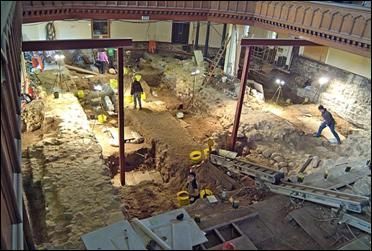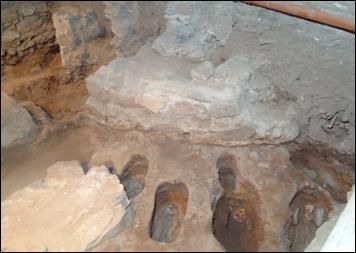Between January and December 2006 one of the most extensive excavations in a medieval parish church took place at Aberdeen’s St Nicholas East Kirk in advance of building work by the church. Post-excavation has still to be completed at this site.

Figure 41: Site showing 15th-century sleeper walls © Aberdeen Art Gallery and Museums Collections
Earliest apsidal church

Figure 42: Apse with child burials © Aberdeen Art Gallery and Museums Collections
The earliest structure excavated on this site was a semi-circular wall and mortar floor. This apse formed the east end of a church which may have been constructed in the late 11th or early 12th century. Associated with the apse was a group of burials of 25 babies and children. Very few of the burials intercut and some had been marked with stones or mussel shells. All had their heads to the west although several were slightly off the E-W alignment giving the appearance that they were radiating from the apse. The burials took place in stone and wooden coffins and some had pillow and cheek stones.
The mid 12th-century east end

Figure 43: Skeleton 129 with Silk hat © Aberdeen Art Gallery and Museums Collections
The mid 12th-century east end was constructed over the earlier apse; several courses of ashlar masonry including buttresses survived as well as one section of internal plastered wall. A stone coffin associated with this church had been sealed by the later 12th-century building work. A series of deep-cut burials associated with the 12th-century churches included several graves which contained coarse textile preserved under the body. Several burials contained the remains of twigs placed at the side of the body and one had two scallop shells next to the head. Pilgrims bought scallop shells in the cathedral at Santiago de Compostela in north-west Spain and would have attached them to their hat or cloak. Four burials had been disturbed by the construction of this mid 12th-century church and the body was then ‘folded’ over out of the way of the new wall. One of these individuals was interred with a lead cross suspended on a copper alloy chain around the neck. Over 300 burials were associated with the 12th-century churches.
Consolidating the 12th-century east end

Figure 44: Late 12th-century east end with pilaster buttress © Aberdeen Art Gallery and Museums Collections
In the late 12th century, the east end gable wall was rebuilt 1m east of the earlier structure. On each of the corners, pilaster buttresses date this wall to the late 12th century. Other buttresses had been damaged by 15th-century building operations.
The ‘sacristy’
A two-storey building 4m wide had been added on to the north side of the 12th-century church; the length of the building was lost when the north wall of the 15th-century church was built. Two steps suggested that this building could be entered from the graveyard.
The 15th-century church
This excavation has shown that the building of the early 19th-century East Kirk utilised the walls and foundations of the 15th-century east end, or choir. A sloping corridor was constructed adjacent, and attached to, the south wall of the 15th-century choir to allow access through the west wall of St Mary’s Chapel. At the north side of the choir a flight of stairs probably went out of use at the Reformation when a vaulted roof was built creating a division between St Mary’s and the choir.
A series of pier bases dug through the walls of the 12th-century choir would have supported the 15th-century church. No pier fragments were found in situ but hundreds of fragments of carved stone from the 15th-century east end were recovered. One carved stone face probably from a ceiling boss had been reused in the manufacture of a 19th-century wall. Several masons’ marks were recorded including a star and an M with a tail.
Nearly 500 burials came from the post-15th century period. These included the burial of a middle-aged female who had suffered from rickets, or osteomalacia, a softening or weakening of the bones caused by lack of vitamin D. This woman was buried with a lead religious badge decorated with an image of Our Lady of Pity (or pieta), the image of the Virgin Mary with the body of Christ supported on her knees. Several areas of up to six burials together suggests family burial ‘vaults’.
Two 19th-century churches
Foundation trenches for walls to support the floors and pews of the 1874 East Kirk were very substantial and had cut through many burials; larger bones had often been carefully reinterred. Areas of burning on the internal face of the south wall and in soil layers were the result of the 1874 fire, showing that the walls were retained but the roof and internal fittings were rebuilt.
The human remains

Figure 45: 12th century church east end and associated burials © Aberdeen Art Gallery and Museums Collections
At the end of the excavation there were 939 separate skeletons and over 3.5 metric tonnes of disarticulated material recovered. Overall preservation was better in the pre than the post 15th-century assemblage as the bone condition in the later coffined burials was poor. About 50% of deaths occurred in infancy with 25% occurring under 3 years of age. Once past childhood there was a good chance of living to 35 years although only 3% reached over the age of 50. After the 15th century there was a lower proportion of childhood deaths, stature increased for both men and women and there was a significant drop in individuals with sinusitis, which possibly suggests better ventilation in living accommodation. Generally more males than females suffered fractured bones and there was a reduction in all types of fractures after the 15th century. There were slightly lower rates of osteoporosis than nationally reported with more females than males affected but there was a high prevalence of rickets, infantile scurvy and of orbitalia in non adults and females. The bones suggest that life in general became less severe after the 15th century – height increased, osteoarthritis, evidence of trauma and number of child burials decrease as a percentage of the burial population, which may, however, equally reflect a changed socio-economic status of the individuals buried.

Comments 1
Recorded Lecture: Excavations at St Nicholas Kirk, AberdeenPart of the Society of Antiquaries Lecture series, this lecture on the excavations at St Nicholas Kirk, Aberdeen was given in March 2011 by Alison Cameron.A full size version can be viewed at Society of Antiquaries of Scotland You Tube Channel